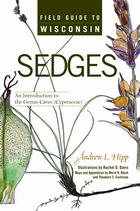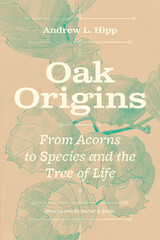2 books about Hipp, Andrew L.

Field Guide to Wisconsin Sedges
An Introduction to the Genus Carex (Cyperaceae)
Andrew L. Hipp; Illustrations by Rachel D. Davis; Maps and Appendices by Merel R. Black and Theodore S. Cochrane
University of Wisconsin Press, 2008
Sedges are among the world’s most diverse and ecologically important plant families, with almost two hundred species in Wisconsin alone. These grass-like plants, found mostly in wetlands, are increasingly popular with landscapers and home gardeners. Learning to identify sedges is challenging, however, and the available technical guides to the sedge family can be overwhelming to a nonspecialist. Field Guide to Wisconsin Sedges is a beautifully illustrated introduction to the largest sedge genus, Carex, which alone makes up about 7 percent of the flora of the upper Midwest.
Written primarily for naturalists, wild plant enthusiasts, and native landscapers, this book is unique in its accessible format and illustrations. With this book, readers can learn to recognize key structures needed to identify approximately 150 Carex species found in Wisconsin. Author Andrew Hipp shows how to identify many of the major groupings of sedges that are used in guides to the genus throughout the world.
Field Guide to Wisconsin Sedges includes information on habitat and range drawn from Hipp’s extensive field experience and inspection of thousands of herbarium sheets. Primarily an identification guide, the book is also a valuable source of habitat information for landscapers, gardeners, and restorationists.
Features:
• Keys to all Wisconsin Carex species, arranged by section
• Distribution maps for all species
• Species descriptions and detailed habitat information for more than 50 common species
• Color illustrations of whole plants or details for more than 70 species
• Appendix summarizing dominant Carex species by Wisconsin habitat
• A glossary of terms
• Water-resistant paperback cover
[more]

Oak Origins
From Acorns to Species and the Tree of Life
Andrew L. Hipp
University of Chicago Press, 2024
From ancient acorns to future forests, the story of how oaks evolved and the many ways they shape our world.
An oak begins its life with the precarious journey of a pollen grain, then an acorn, then a seedling. A mature tree may shed millions of acorns, but only a handful will grow. One oak may then live 100 years, 250 years, or even 13,000 years. But the long life of an individual is only a part of these trees’ story.
With naturalist and leading researcher Andrew L. Hipp as our guide, Oak Origins takes us through a sweeping evolutionary history, stretching back to a population of trees that lived more than 50 million years ago. We travel to the ancient tropical Earth to see the ancestors of the oaks evolving side by side with the dinosaurs. We journey from the oaks’ childhood in the once-warm forests of the Arctic to the montane cloud forests of Mexico and the broad-leaved evergreen forests of Southeast Asia. We dive into current research on oak genomes to see how scientists study genes’ movement between species and how oaks evolve over generations—spanning tens of millions of years. Finally, we learn how oak evolutionary history shapes the forests we know today, and how it may even shape the forests of the future.
Oaks are familiar to almost everyone, and beloved. They are embedded in our mythology. They have fed us, housed us, provided wood for our ships and wine barrels and homes and halls, planked our roads, and kept us warm. Every oak also has the potential to feed thousands of birds, squirrels, and mice and host countless insects, mosses, fungi, and lichens. But as Oak Origins makes clear, the story of the oaks’ evolution is not just the story of one important tree. It is the story of the Tree of Life, connecting all organisms that have ever lived on Earth, from oaks’ last common ancestor to us.
An oak begins its life with the precarious journey of a pollen grain, then an acorn, then a seedling. A mature tree may shed millions of acorns, but only a handful will grow. One oak may then live 100 years, 250 years, or even 13,000 years. But the long life of an individual is only a part of these trees’ story.
With naturalist and leading researcher Andrew L. Hipp as our guide, Oak Origins takes us through a sweeping evolutionary history, stretching back to a population of trees that lived more than 50 million years ago. We travel to the ancient tropical Earth to see the ancestors of the oaks evolving side by side with the dinosaurs. We journey from the oaks’ childhood in the once-warm forests of the Arctic to the montane cloud forests of Mexico and the broad-leaved evergreen forests of Southeast Asia. We dive into current research on oak genomes to see how scientists study genes’ movement between species and how oaks evolve over generations—spanning tens of millions of years. Finally, we learn how oak evolutionary history shapes the forests we know today, and how it may even shape the forests of the future.
Oaks are familiar to almost everyone, and beloved. They are embedded in our mythology. They have fed us, housed us, provided wood for our ships and wine barrels and homes and halls, planked our roads, and kept us warm. Every oak also has the potential to feed thousands of birds, squirrels, and mice and host countless insects, mosses, fungi, and lichens. But as Oak Origins makes clear, the story of the oaks’ evolution is not just the story of one important tree. It is the story of the Tree of Life, connecting all organisms that have ever lived on Earth, from oaks’ last common ancestor to us.
[more]
READERS
Browse our collection.
PUBLISHERS
See BiblioVault's publisher services.
STUDENT SERVICES
Files for college accessibility offices.
UChicago Accessibility Resources
home | accessibility | search | about | contact us
BiblioVault ® 2001 - 2025
The University of Chicago Press









